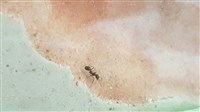
BY ALPER ÖZKAN (MSN/PhD)
d_ozkan@ug.bilkent.edu.tr
I had long had it in mind to build an ant farm, thanks in no small part to a carpenter ant queen that I found last September, which overwintered in my office and started to produce her first workers this spring. I did not, however, have time for this project until a couple of weeks ago, when I finally got the chance to assemble a small formicarium in a spare fish tank. The colony is now adjusting to its new, long-term home, and since carpenter ant queens can live for two decades or so, it may be a continuing attraction on UNAM’s fourth floor for years to come. (I will hopefully graduate this summer, but the ant farm, alongside my apple snail and other “side projects,” will probably be a gift for the next occupant of my office.) This being the case, it is a very good time to talk about ants, which despite their mostly generalized diet (best summarized as “everything that moves, and most things that don’t”) have evolved a good number of specialized tactics to establish their dominance over the earth.
Ants are difficult prey mainly because they are well-defended, both individually and as a group: in addition to their ability to recruit nestmates to sites of battle, almost every species of ant is equipped with a nasty bite, many are further protected by their stings (some of which rank among the nastiest in the animal kingdom), and some will even spray formic acid into the eyes of their enemies (and sometimes utilize a combo attack where they will bite to draw blood and deliver formic acid into the wound for extra pain). As with spiders, however, select ants have more specialized defenses—Polyrhachis workers, for example, often possess hook-like spines that allow the insects to lodge themselves in the throats of birds brave enough to attack them, while some carpenter ants (among other ant genera—the trait has evolved more than once) use their flattened heads as doors for their nests (and queens of a Pheidole species use their abdomens for the job, just like certain trapdoor spiders—again, convergent evolution at work). “Suicide” ants, which flex their muscles with enough force to burst their heads open and drown their enemies in a torrent of glue, are also now famous on the internet, as are trap-jaw ants, which, in addition to being able to bisect prey insects with a snap of their mandibles, also use the “recoil” of their strikes to jump away from potential enemies.
But due to their ground-dwelling habits and sprawling nests, ants are exceptionally susceptible to enemies from within—an arboreal wasp nest, for example, can only be entered from the air or through a single, narrow stalk that connects it to its tree (and even that is often covered with chemical deterrents secreted by the wasps), but an ant nest is an open buffet for any animal capable of fending off or hiding among its guardians. Ants, like many other social insects, identify nestmates through a mixture of cuticular hydrocarbons, but this can be imitated or stolen—some jumping spiders, for example, gain the ability to infiltrate ant nests only after eating the larvae of that particular nest, while other, more specialized nest-guests synthesize their own blend and alter it to suit individual colonies once they settle in (some also enhance their disguise with queen-specific sounds). Ants themselves are not above this kind of deceit, as certain queens can develop only if they kill a queen from a closely related species and trick her first workers into rearing a foreign brood, while the famed “slave-making” ants exhibit a similar behavior on a much larger scale: workers that emerge in a colony other than their birthplace adjust to the new colony’s odor and behave as its members, so these ants steal larvae and pupae from other colonies to use as their own. Some of these “slavers” are so dependent on this method that when left without foreign workers, they cannot feed themselves or look after their own offspring.
Other parasites deal with ants by becoming impervious to them—although they are doubtlessly pugnacious fighters, ants will grudgingly tolerate foreign elements that they cannot overcome, and well-armored beetles in particular can eke out a living in ant nests if they stay away from frequently used chambers. But by far the most striking ant parasites plague army ants…and are birds. This is, to my knowledge, the only instance of a vertebrate parasitizing an invertebrate, and involves birds “stealing” prey from army ants that flush out a great number of prey animals in their famous raids—these are such major events that army ant bivouacs are followed by hundreds of different species, and while these opportunists were once thought to only capture flying insects that the ants wouldn’t have caught anyway, it is now known that they are in fact kleptoparasites that deprive ants of their rightful prey.
The hunting tactics of ants are also colorful, especially in basal species and prey specialists, and will be the topic of the next week’s column. Finally, the picture here is that of a worker from my newly established ant farm—I owe thanks to Ahmet Emin Topal for the photo.
